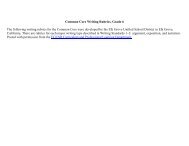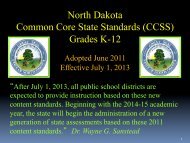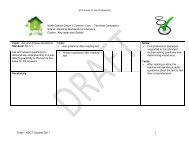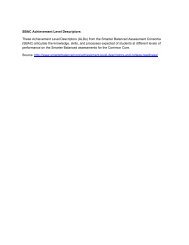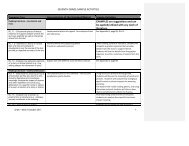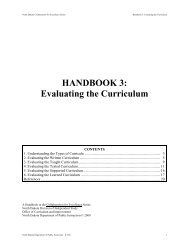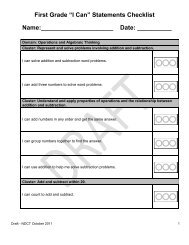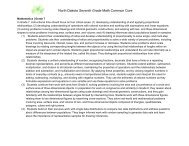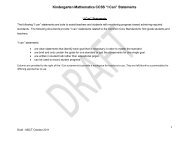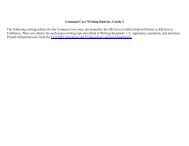A. ND Mathematics Content Standards, Grade 5 - ND Curriculum ...
A. ND Mathematics Content Standards, Grade 5 - ND Curriculum ...
A. ND Mathematics Content Standards, Grade 5 - ND Curriculum ...
Create successful ePaper yourself
Turn your PDF publications into a flip-book with our unique Google optimized e-Paper software.
Introduction<br />
Toward greater focus and coherence<br />
<strong>Mathematics</strong> experiences in early childhood settings should concentrate on (1) number (which includes whole number, operations , and relations) and (2)<br />
geometry, spatial relations, and measurement, with more mathematics learning time devoted to number than to other topics. Mathematical process goals<br />
should be integrated in these content areas.<br />
—National Research Council, 2009<br />
The composite standards [of Hong Kong, Korea and Singapore] have a number of features that can inform an international benchmarking process for the<br />
development of K–6 mathematics standards in the U.S. First, the composite standards concentrate the early learning of mathematics on the number,<br />
measurement, and geometry strands with less emphasis on data analysis and little exposure to algebra. The Hong Kong standards for grades 1–3 devote<br />
approximately half the targeted time to numbers and almost all the time remaining to geometry and measurement.<br />
— Ginsburg, Leinwand and Decker, 2009<br />
Because the mathematics concepts in [U.S.] textbooks are often weak, the presentation becomes more mechanical than is ideal. We looked at both<br />
traditional and non-traditional textbooks used in the US and found this conceptual weakness in both.<br />
— Ginsburg et al., 2005<br />
There are many ways to organize curricula. The challenge, now rarely met, is to avoid those that distort mathematics and turn off students.<br />
— Steen, 2007<br />
For over a decade, research studies of mathematics education in high-performing countries have pointed to the conclusion that the mathematics<br />
curriculum in the United States must become substantially more focused and coherent in order to improve mathematics achievement in this country. To<br />
deliver on the promise of common standards, the standards must address the problem of a curriculum that is “a mile wide and an inch deep.” These<br />
<strong>Standards</strong> are a substantial answer to that challenge.<br />
It is important to recognize that “fewer standards” are no substitute for focused standards. Achieving “fewer standards” would be easy to do by resorting to<br />
broad, general statements. Instead, these <strong>Standards</strong> aim for clarity and specificity.<br />
Assessing the coherence of a set of standards is more difficult than assessing their focus. William Schmidt and Richard Houang (2002) have said that<br />
content standards and curricula are coherent if they are:<br />
articulated over time as a sequence of topics and performances that are logical and reflect, where appropriate, the sequential or<br />
hierarchical nature of the disciplinary content from which the subject matter derives. That is, what and how students are taught<br />
should reflect not only the topics that fall within a certain academic discipline, but also the key ideas that determine how knowledge<br />
North Dakota <strong>Mathematics</strong> <strong>Content</strong> <strong>Standards</strong><br />
Based on the Common Core State <strong>Standards</strong><br />
Introduction 1 June 2011



